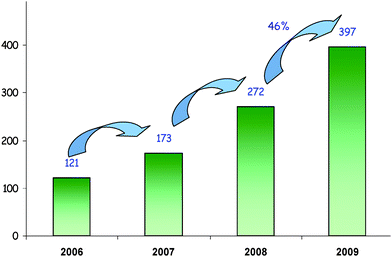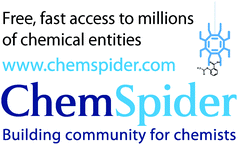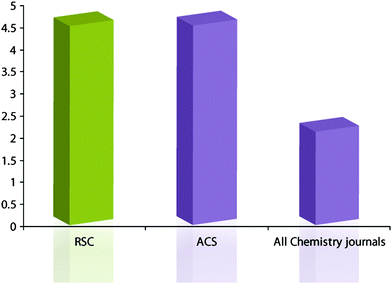CrystEngComm—first for design and understanding of the solid state
Happy New Year from CrystEngComm and the RSC! We would like to take this opportunity to thank all our authors, referees and readers for your continued support which enables CrystEngComm to flourish. 2009 was another successful year for the journal, which saw the impact factor increase to 3.535 and the journal remain at pole position in immediacy index for crystal engineering journals, with a 2008 immediacy index of 0.694.† We take this opportunity to highlight some of the achievements made by CrystEngComm in 2009 and to tell you about our plans for the future.Crystal engineering has an increasingly broad footprint, which covers all the traditional areas of chemistry. In order to reflect this dynamic and rapidly changing field, CrystEngComm will extend its focus to research concerning the morphology of crystals, solution phase studies of intermolecular interactions, controlling crystal growth and amorphous solids. With its fast publication times and highest immediacy index, CrystEngComm remains the obvious journal of choice for publishing the most current research relating to the design and understanding of the solid state.
CrystEngComm: growing fast
CrystEngComm continued to grow significantly in 2009 with the total number of published articles increasing by 46% (Fig. 1). In addition, a study carried out in 2009 showed that CrystEngComm is still the crystal engineering journal with the fastest publication times. On average, full articles are published 71 days faster in CrystEngComm than in other leading journals in its field, while communications are 62 days quicker.‡ | ||
| Fig. 1 Number of published articles in CrystEngComm. | ||
CrystEngComm: supporting the community
As ever we have been delighted this year to have the opportunity to meet many CrystEngComm authors and readers at national and international conferences and events. In August, Dr Jamie Humphrey and Dr Stuart James (CrystEngComm editorial board member) organised a popular Crystal Engineering symposium at the 42nd IUPAC Congress held in Glasgow. Speakers included Susumu Kitagawa (Kyoto University, Japan) and Joel Bernstein (Ben-Gurion University, Israel) to name a few.At CrystEngComm we are proud to reward and support young, up and coming researchers in the community. In 2009 we have continued to award a number of prizes at international conferences, to recognise the best crystal engineering research presented. We wish to congratulate all our 2009 CrystEngComm prize winners and welcome readers suggestions for conferences where we could offer sponsorship or CrystEngComm poster prizes in 2010—please do contact us at mailto:CRYSTENGCOMM-RSC@rsc.org.
We are continuing to add more features to CrystEngCommunity which is the home on the web for those interested in crystal engineering and crystal growth. On the site you will find links to international research groups, conferences and events, and latest research highlights. This year we introduced CrystEngCommunity interviews and CrystEngCommunity conference reports, so you can now read regular interviews from researchers and reports from conferences relevant to crystal engineering and crystal growth. Send us your conference reports and we will publish them on the site. The CrystEngCommunity interactive map allows you to easily find crystal engineering research groups from all over the world. Help the community to grow by adding your group to the map! Find CrystEngCommunity at www.rsc.org/Publishing/Community.
2009 CrystEngComm prize winnersHiroshi Yamamoto, RIKEN, Japan, Fall ACS, 16–20 August 2009, Washington DC, USA Jessica Urbelis, Georgetown University, ACA meeting, 25–30 July 2009, Toronto, Canada Robert T Berendt, University of Kansas, Midwest Organic Solid-State Chemistry Symposium5–6 June 2009, St Louis, USA David Alonzo, Purdue University, USA, Midwest Organic Solid-State Chemistry Symposium, 5–6 June 2009, St Louis, USA Sekai Iwama, Kyoto University, Japan, International Conference on the Chemistry of the Organic Solid State 14–19 June 2009, Sestri Levante, Italy Claire Murray, University of Reading, UK, British Crystallographic Association Annual Spring Meeting 21–23 April 2009, Loughborough, UK |
CrystEngComm: themed issues
We hoped you enjoyed our 2009 themed issues on ‘Mechanochemistry and co-crystals’ (guest editors: Stuart James and Ashwini Nangia; issue 3, 2009) and ‘Crystal engineering in molecular magnetism’ (guest editors: Concepció Rovira and Jaume Veciana; issue 10, 2009). Look out for our forthcoming themed issue focusing on the growing field of Molecular Solids at Extreme Pressure (guest editor: Simon Parsons, University of Edinburgh, UK), which will be published towards the end of next year. Next year will also see the advent of a special themed issue in CrystEngComm to highlight the excellent work being carried out by the younger members of the community, those rising stars in the field of crystal engineering.With your continued support, we look forward to building on our success over the coming year. It is the authors, referees and readers who allow the journal to thrive, and thank you again for all the suggestions and support you provided in 2009. We welcome all conference suggestions, themed issue ideas, comments and feedback; please do contact us at mailto:CRYSTENGCOMM-RSC@rsc.org with your ideas and views.
Best wishes for the New Year from all the team at CrystEngComm!
Jamie Humphrey
Editor
Neil Champness
Chair, Editorial Board
Michelle Canning
Assistant Manager
Ruth Doherty
Deputy Editor
Lorena Tomas-Laudo
Development Editor
News from RSC publishing
RSC Publishing is proud to announce the launch of our powerful new content delivery platform that supports multiple content types. Powered by the industry's leading MarkLogic Server, and benefiting from the interactive browsing functionality offered by RSC's enhanced html mark-up technology, the platform delivers exceptionally fast and precise results. Users can now search 165 years of world-class RSC-hosted content including 20![[thin space (1/6-em)]](https://www.rsc.org/images/entities/char_2009.gif) 000 book chapters, 300
000 book chapters, 300![[thin space (1/6-em)]](https://www.rsc.org/images/entities/char_2009.gif) 000 journal articles and 450
000 journal articles and 450![[thin space (1/6-em)]](https://www.rsc.org/images/entities/char_2009.gif) 000 database records from a single, simple search. Designed around readers' preferences (identified from a detailed and ongoing user-interview process), our user-friendly platform offers faster browsing, intelligent searching, consistent user experience irrespective of content type sought, and simpler more intuitive navigation. We'll be releasing even more exciting functionality later in the year. Please tell us what you think at mailto:rscpublishing@rsc.org
000 database records from a single, simple search. Designed around readers' preferences (identified from a detailed and ongoing user-interview process), our user-friendly platform offers faster browsing, intelligent searching, consistent user experience irrespective of content type sought, and simpler more intuitive navigation. We'll be releasing even more exciting functionality later in the year. Please tell us what you think at mailto:rscpublishing@rsc.org
ChemSpider
Last year RSC acquired ChemSpider, the richest single source of structure based chemistry information freely available online, with fast searching of over 21.5 million chemical structures. Alongside the powerful database, the ChemSpider development team brings well over 40 years of additional cheminformatics experience to the RSC, including a chemistry centric document mark-up system capable of finding chemical names and converting to chemical structures and linking to online resources. Integration of this technology with RSC's existing award winning enhanced html mark-up technology, RSC Prospect, will lead to substantial enhancements in semantic enrichment for the chemical sciences. Find out more at www.chemspider.comImpact factors
Publication of the 2008 impact factors, calculated by ISI, once again brought good news for authors and readers of RSC journals. Nearly all the RSC journals increased in impact factor, immediacy index and article influence, with an impressive average impact factor increase of 8.2%. Overall, the average impact factor for the RSC portfolio now stands at 4.7, equal to that of the ACS collection.
RSC journals feature in the top 10 rankings (by impact factor and immediacy index) in 6 of the 7 core chemistry categories as listed on ISI, and of the top 100 chemistry journals, ranked by impact factor, 15 are from RSC Publishing.
New ways of alerting you
2009 saw the launch of the new RSC journal e-alerts; in 2010 we are hoping to see continued rise in their popularity. The e-alerts are packed with information and links enabling readers to easily view content as soon as it's published, helping them to stay abreast of journal content. The new e-alert registration system has been designed so readers can manage their own subscriptions, tailoring the information they receive and giving them the freedom to unsubscribe at any point. You can find out more information online: www.rsc.org/alertsRSC eBook subject collections
In response to readers' needs and testament to the innovation of RSC Publishing, we are pleased to announce the launch of new RSC eBook subject collections.The 9 new RSC eBook subject collections, including a tutorial chemistry texts and paperbacks package, deliver the high quality content contained in our books into subject specialist packages. With new content being uploaded throughout the year, the new RSC eBook subject collections are set to become another key, premier resource. To find out more, please visit www.rsc.org/ebooks.
The RSC's new flagship journal Chemical Science will launch in mid-2010, and will publish findings of exceptional significance from across all the chemical sciences. Editor-in-Chief Professor David MacMillan of Princeton leads a dynamic international team of Associate Editors responsible for the scientific development of the journal. Free institutional online access to the entire 2010 and 2011 content of Chemical Science will be automatically provided to all existing customers. Keep in touch with the latest news at www.rsc.org/chemicalscience. Free institutional online access is available for all our newest journals. Access, which is managed by institution and IP address, is provided following a simple registration process. Make sure you and your colleagues don't miss out on the free access by filling in the registration form:www.rsc.org/free_access_registration.
On a related note, RSC is pleased to announce a significant new global symposia series supporting the launch of the Chemical Science. The International Symposia on Advancing the Chemical Sciences (ISACS) meetings will be held on three continents, over three sequential weeks, focusing on distinct subject areas. More information can be found at: www.rsc.org/isacs.
Nanoscale, a new journal encompassing experimental and theoretical work across the breadth of nanoscience and nanotechnology, met with resounding success when it published its first articles in August 2009. Now in its second volume, the journal, which is a collaborative venture between RSC Publishing and the National Center for Nanoscience and Technology (NCNST) in Beijing, China, continues to showcase important and high quality nano-research, providing a forum that is essential reading for all scientific communities working at the nanoscale. Read more at www.rsc.org/nanoscale.
Free institutional online access is available for all our newest journals. Access, which is managed by institution and IP address, is provided following a simple registration process. Make sure you and your colleagues don't miss out on the free access by filling in the registration form: www.rsc.org/free_access_registration
Footnotes |
| † 2008 Impact Factor and Immediacy Index, as published by Thomson ISI. |
| ‡ Based on an analysis of crystal engineering journals studying the times to publication of articles in 2009 issues 1–4. |
| This journal is © The Royal Society of Chemistry 2010 |


